Page 1 of 1
black smoke good or bad
Posted: Thu Oct 30, 2008 8:23 pm
by bludger
got my 2h turbo tuned today after putting t on over the weekend and now there is bit of black smoke coming out when you give some on take off is that good all bad the turners said the turbo is good and only running 5psi
good or bad
cheers
Posted: Thu Oct 30, 2008 8:52 pm
by vSAHARAx
Its only unburnt fuel. Now you have the turbo and had the fuel matched its now getting the fuel it needs when on boost. Only side effect is because the injector pump doesnt have a boost compensator, when you take off that little bit of extra fuel being delivered is not being burnt because the turbo hasnt spooled up in order to burn it efficiently. It is normal for a diesel to smoke on take off or when driven hard. You look at all the modern diesels. for example all the diesel BMW X5's, ML320's, 200 series cruisers, D40 navaras and pathy's. They all still blow black smoke. The joys of an oiler

If you have gone to all the effort of installing a turbo and had it tuned why are you only running 5 psi??? seems like wasted potential.
Troy
Posted: Thu Oct 30, 2008 8:58 pm
by bludger
the guy at the turbo said thats all it needs your engine will last longer i was expecting around 9 or 10 psi and its real quite even after putting a new 3in exhaust on her
Posted: Sat Nov 01, 2008 11:48 pm
by GeneralFubashi
The guy at the turbo shop was right in expecting it to las longer, general consensus is that 5-6psi is about the most reliable you will get from a 2h. More will give better power, but more boost created problems in some engines.
Sam
Posted: Sun Nov 02, 2008 6:24 am
by balzackracing
I would be pumping a bit more than 5psi into it, crank it to 10. Boost is relevant to engine load, if your plodding around town you will be making bugger boost. If your giving the old oiler a work out towing a trailer up a hill or trying to over take then you will reach your maximum boost pressure, which dosent happen all that often but thats where you want the engine to be producing as much torque as it can. But thats just my opinion.
Posted: Sun Nov 02, 2008 6:27 am
by chpd80
does it have a muffler in the 3" exhaust system. alot of guys run without them as the turbo is a great muffler itself. so to speak.
Thats how you get that great deisel crackle.
chop it out and see how loud it is, you can always weld it back in.

I would run 8-9 pound boost with a pryo if worried about engine life.
more if I wasnt at all worried.
5-6 is a waste of your effort fitting it.
Black smoke if fine.
Posted: Sun Nov 02, 2008 8:06 am
by FJ turbo 75
What turbo set up have you got .
And if it is an AXT by chance how do you turn up the boost as i have just got mine back on the road amd put approx 2500klm on the new motor and now want some more power too.
Posted: Sun Nov 02, 2008 10:42 am
by balzackracing
FJ turbo 75 wrote:What turbo set up have you got .
And if it is an AXT by chance how do you turn up the boost as i have just got mine back on the road amd put approx 2500klm on the new motor and now want some more power too.
This may be a little bit off subject but i figured that may be some people are not quite up to speed on the whole turbo subject, so I figured I would pass on some of my knowledge from the many years of experiance as a diesel fitter, trainer and supervisor with Caterpillar.
There are a few ways of increasing the boost pressure, but first I'll give you a little bit of an idea as to how the boost is limited in the first place.
There are two basic set ups, internal waste gated and external waste gated. As the names suggest, the internal waste gate in mounted into the turbine housing of the turbo and an external waste gate is mounted on the exhaust manifold just before the turbo and allows the exhaust gas to bypass the turbo and go straight into the exhaust.
Booth styles of waste gates have a spring and diaphragm that actuate the exhaust valve that is the waste gate. The diaphragm is also connected to a small hose that runs from a fitting mounted some where between the outlet of the impeller housing on the turbo and intake of the engine. This hose is a signal line that allows the pressure created in the intake of the engine to act upon the diaphragm. At low boost pressure or vacuum the waste gate is closed as there is not enough force to overcome the spring pressure within the diaphragm. As the engine builds up load and the turbo reaches its boost pressure the signal line transfers that pressure down to the diaphragm which now has sufficient force to overcome the spring pressure and open the waste gate, this then allows the exhaust gasses to bypass the turbine wheel and go straight into the exhaust system. The loss of gas velocity causes the turbo to slow down thus producing less intake pressure (boost). Then as the pressure drops away from the intake and thus the diaphragm, the waste gate closes allowing the turbo to start building up pressure then the whole process starts again.
Pew that was a lot!
OK so how do you increase the boost pressure??
By changing the weight of the spring to one with a higher tension is the most common. This results in more pressure being required to act upon the diaphragm to open the waste gate, thus increasing boost.
Another way is to install one of the many styles of boost control valves. These valves are basically a very small regulator that mount inline with the boost signal line witch in a very basic way of saying "lies" to the diaphragm. The turbo then needs to build up more pressure to actuate waste gate. These valves are usually cheap and easily available from autobahn / supercheap etc. As a bonus there is an electronic style of these valves that allows you to have two preset boost pressures and change from one to the other at a flick of a switch.
The last way is to either remove and block off or simply kink the signal line from the intake to the diaphragm on the waste gate. Doing this will cause the turbo to work at its maximum limit (usually set by both the size and design of the turbo or the size of the engine) as the waste gate no longer have any effect. Very few industrial size diesel engines use waste gates at all, most rely only on the correct sizing of the turbo’s to maintain the boost limits.
It is also important to remember that increasing boost is on a section of the equation to increasing power. The whole point of increasing boost pressure is to put more oxygen into the cylinders, more oxygen then allows more fuel to be added to give a bigger bang, bigger bang = more power.
Sorry it took so long to get to the point but if I had just said change the spring in the diaphragm then you would probably want to know why.
Cheers,
Busty
Posted: Sun Nov 02, 2008 4:23 pm
by FJ turbo 75
Thanks Busty that was a great explanation ,
PS Say hello to Greg AKA devo and Veronica AKA Vee out your way if ya know e'mm
Posted: Sun Nov 02, 2008 5:50 pm
by balzackracing
FJ turbo 75 wrote:Thanks Busty that was a great explanation ,
PS Say hello to Greg AKA devo and Veronica AKA Vee out your way if ya know e'mm
Can't say I do, But your welcome
Posted: Mon Nov 03, 2008 7:52 am
by turkey
Ripper post Busty

Posted: Mon Nov 03, 2008 11:53 am
by Grimey
that deserves a sticky or something:)
Posted: Mon Nov 03, 2008 2:04 pm
by bludger
heres is a couple of pics of the turbo off the 60 and on the 60 and all i know its a garrett turbo nothing else
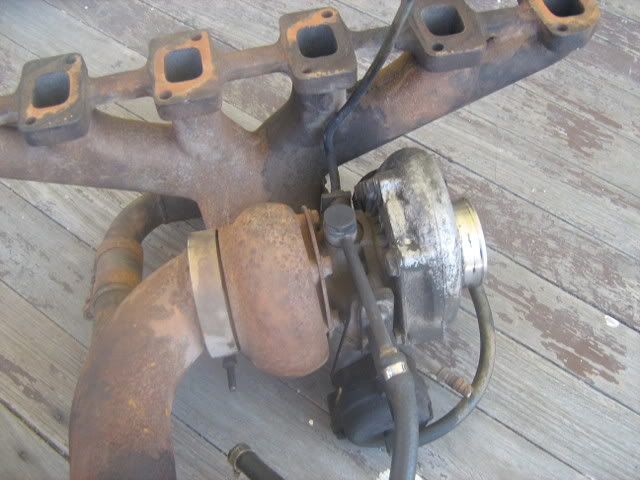
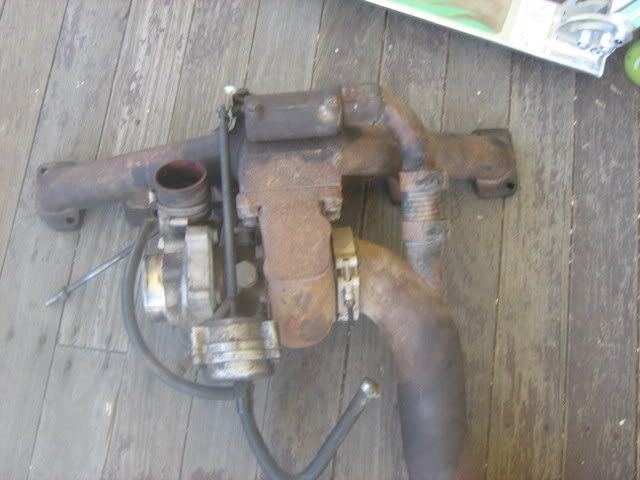
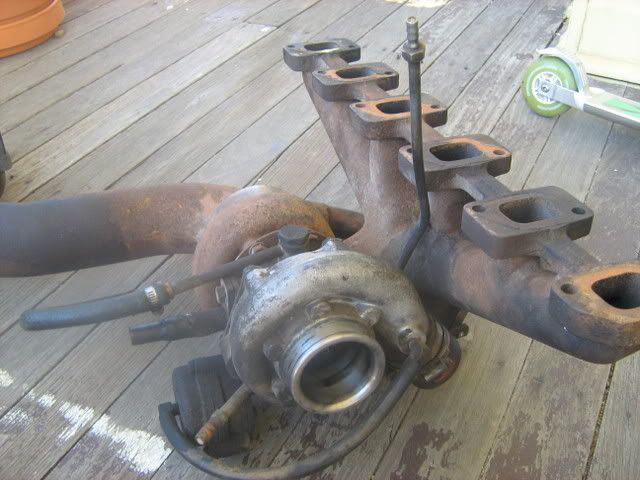

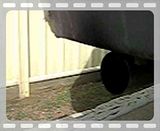
now to try and get some more boost out of her not much proberly around 9 or 10 psi
any ideas
cheers
Posted: Mon Nov 03, 2008 2:19 pm
by bludger
balzackracing wrote:FJ turbo 75 wrote:What turbo set up have you got .
And if it is an AXT by chance how do you turn up the boost as i have just got mine back on the road amd put approx 2500klm on the new motor and now want some more power too.
This may be a little bit off subject but i figured that may be some people are not quite up to speed on the whole turbo subject, so I figured I would pass on some of my knowledge from the many years of experiance as a diesel fitter, trainer and supervisor with Caterpillar.
There are a few ways of increasing the boost pressure, but first I'll give you a little bit of an idea as to how the boost is limited in the first place.
There are two basic set ups, internal waste gated and external waste gated. As the names suggest, the internal waste gate in mounted into the turbine housing of the turbo and an external waste gate is mounted on the exhaust manifold just before the turbo and allows the exhaust gas to bypass the turbo and go straight into the exhaust.
Booth styles of waste gates have a spring and diaphragm that actuate the exhaust valve that is the waste gate. The diaphragm is also connected to a small hose that runs from a fitting mounted some where between the outlet of the impeller housing on the turbo and intake of the engine. This hose is a signal line that allows the pressure created in the intake of the engine to act upon the diaphragm. At low boost pressure or vacuum the waste gate is closed as there is not enough force to overcome the spring pressure within the diaphragm. As the engine builds up load and the turbo reaches its boost pressure the signal line transfers that pressure down to the diaphragm which now has sufficient force to overcome the spring pressure and open the waste gate, this then allows the exhaust gasses to bypass the turbine wheel and go straight into the exhaust system. The loss of gas velocity causes the turbo to slow down thus producing less intake pressure (boost). Then as the pressure drops away from the intake and thus the diaphragm, the waste gate closes allowing the turbo to start building up pressure then the whole process starts again.
Pew that was a lot!
OK so how do you increase the boost pressure??
By changing the weight of the spring to one with a higher tension is the most common. This results in more pressure being required to act upon the diaphragm to open the waste gate, thus increasing boost.
Another way is to install one of the many styles of boost control valves. These valves are basically a very small regulator that mount inline with the boost signal line witch in a very basic way of saying "lies" to the diaphragm. The turbo then needs to build up more pressure to actuate waste gate. These valves are usually cheap and easily available from autobahn / supercheap etc. As a bonus there is an electronic style of these valves that allows you to have two preset boost pressures and change from one to the other at a flick of a switch.
The last way is to either remove and block off or simply kink the signal line from the intake to the diaphragm on the waste gate. Doing this will cause the turbo to work at its maximum limit (usually set by both the size and design of the turbo or the size of the engine) as the waste gate no longer have any effect. Very few industrial size diesel engines use waste gates at all, most rely only on the correct sizing of the turbo’s to maintain the boost limits.
It is also important to remember that increasing boost is on a section of the equation to increasing power. The whole point of increasing boost pressure is to put more oxygen into the cylinders, more oxygen then allows more fuel to be added to give a bigger bang, bigger bang = more power.
Sorry it took so long to get to the point but if I had just said change the spring in the diaphragm then you would probably want to know why.
Cheers,
Busty
top info got me interrested


Posted: Mon Nov 03, 2008 3:30 pm
by balzackracing
Checked out your video, didn't look to bad to me. Typical turbo 2H.
I was intrested to see your pictures as I have never seen a 2H turbo kit with and external waste gate before I have labled some pics for you to give you an idea what Im talking about.

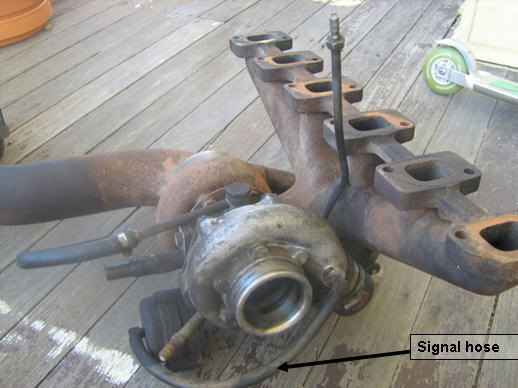
If you install one of the boost control valves linked below you into the signal line then you will be able to wind the boost up easy as.
http://store.autospeed.com/Items/14818? ... 0(GBCV-IC)
hope this helps.
Posted: Mon Nov 03, 2008 5:42 pm
by dogbreath_48
Out of curiosity - where do the oil/water lines hook up to the engine?
Posted: Mon Nov 03, 2008 6:21 pm
by bludger
balzackracing wrote:Checked out your video, didn't look to bad to me. Typical turbo 2H.
I was intrested to see your pictures as I have never seen a 2H turbo kit with and external waste gate before I have labled some pics for you to give you an idea what Im talking about.


If you install one of the boost control valves linked below you into the signal line then you will be able to wind the boost up easy as.
http://store.autospeed.com/Items/14818? ... 0(GBCV-IC)
hope this helps.
thanks for that now i'm going out to buy one i dont want too much boost just a little bit more than 5psi got to change the 4 speed to a 5 speed to now revs out a little bit to much then someone told me to put 35s on that should sort it out i hope so
any ideas
cheers
Posted: Mon Nov 03, 2008 6:27 pm
by bludger
dogbreath_48 wrote:Out of curiosity - where do the oil/water lines hook up to the engine?
i took my oil sender unit out and put a t piece in with a new sender unit in then i attached a hose from there to the turbo and the outlet oil i put pipe into the sup so the oil could drain back into i haven't done the water yet i'm thinking about intercooler down the track when i got the $$$
Posted: Mon Nov 03, 2008 7:13 pm
by dogbreath_48
bludger wrote:dogbreath_48 wrote:Out of curiosity - where do the oil/water lines hook up to the engine?
i took my oil sender unit out and put a t piece in with a new sender unit in then i attached a hose from there to the turbo and the outlet oil i put pipe into the sup so the oil could drain back into i haven't done the water yet i'm thinking about intercooler down the track when i got the $$$
Thanks! Has that made any difference to oil pressure gauge readings?
Posted: Tue Nov 04, 2008 8:33 pm
by fester2au
Not sure how you know you're running 5 psi. don't say if you have a boost gauge or did you get that off the turbo tuners.
If you don't have a boost gauge then get one before you start playing with boost and remember very small changes at a time and test under full load conditions between each change to make sure you are seeing max boost. and buy a good boost gauge, they are not that dear, not those cheap arse ebay chinese name brands. Exhaust temp would also be really handy at the same time also but at 9-10 psi you shouldn't be too bad if tuned properly. Really you should have your fuel pump set to the higher settings to be spot on. Doing it a little arse about face unfortunately but probably not too bad as it's still pretty tame. Have fun.
Posted: Wed Nov 05, 2008 9:20 am
by bludger
fester2au wrote:Not sure how you know you're running 5 psi. don't say if you have a boost gauge or did you get that off the turbo tuners.
If you don't have a boost gauge then get one before you start playing with boost and remember very small changes at a time and test under full load conditions between each change to make sure you are seeing max boost. and buy a good boost gauge, they are not that dear, not those cheap arse ebay chinese name brands. Exhaust temp would also be really handy at the same time also but at 9-10 psi you shouldn't be too bad if tuned properly. Really you should have your fuel pump set to the higher settings to be spot on. Doing it a little arse about face unfortunately but probably not too bad as it's still pretty tame. Have fun.
turbo turners told me they only set it at 5psi went end bought a boost gauge on the weekend from supercheap auto and installed it and that only says 5psi so i'm going to go to a better turner these guys just done by ear and used there own boost gauge still good on fuel i'm going to go out and buy a boost controller soon
cheers






